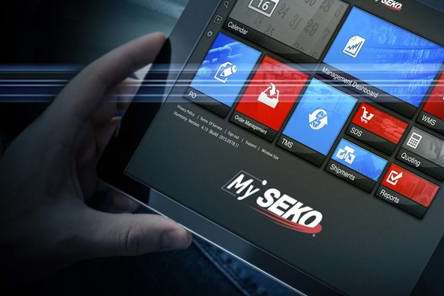Say goodbye to the grind of shipping tasks as software paves the way for smoother freight forwarding operations.
Daniel Eckett, SEKO's Client Solutions Director for the UK and Ireland, explores what freight forwarding is, how it works, and sheds light on the transformative power of freight forwarding software.
Eckett says that freight forwarding software has shifted from a nice-to-have feature to an essential requirement.
What is freight forwarding?
In global logistics, freight forwarding is a service used by companies to facilitate the international import and export of goods.
A freight forwarder doesn’t physically move freight itself, but it does act as an intermediary between the client and whichever transportation service they are using. This may include air freight, ocean freight and trucking.
But that’s not all a freight forwarder does. Let’s explore some of the wider responsibilities that come with the role.
What does a freight forwarder do?
Freight forwarders have a varied range of tasks within a global logistics operation. Some of these tasks include:
-
Arranging transportation (air, ocean, road, rail) for cargo.
-
Selecting and booking carriers for optimal cost, speed, and reliability.
-
Negotiating freight rates and terms with carriers.
-
Managing customs brokerage and ensuring compliance with import/export regulations.
-
Preparing and submitting shipping documentation, including bills of lading and waybills.
-
Tracking and monitoring shipments, providing status updates to clients.
-
Consolidating and deconsolidating shipments to optimise space and cost.
-
Advising on packaging, labelling, and loading for safe and compliant transport.
-
Arranging cargo insurance and handling insurance claims when necessary.
Depending on the specific circumstances of the operation, freight forwarders may be asked to perform some additional tasks.
How does freight forwarding work?
In a typical operation, freight forwarding begins with export haulage. This is where goods are transported from the port of origin to the freight forwarder’s warehouse. This is typically done by truck, although there are other types of transport.
Then comes the customs clearance process. Here, customs agents need to verify that the goods are not only legal and safe, but are also properly documented. Freight forwarders often rely on specialised customs brokers to handle this step.
Once clearance is permitted, the goods are unloaded at the warehouse and inspected for any damage or non-compliance.
The next step following the transportation of the goods is import customs clearance, which occurs when the goods arrive in the destination country.
Like in the export customs phase, customs agents will inspect the goods and ensure that all paperwork is in order. Any import fees are typically handled by the freight forwarder and later billed to the shipper.
Once the goods are cleared at the port of destination, they are prepared for transportation to their final destination, often by a local transportation company chosen by the freight forwarder.
Finally, haulage is again involved to move the goods from the import warehouse to their final destination.
To aid with this process, freight forwarders often rely on specialised software to help them meet their obligations.
Can you provide your perspective on freight forwarding software?
Freight forwarding software simplifies the daily tasks of freight management, combining a range of data sources into a single platform. There are many software solutions on the market, but to use SEKO as an example, we use our solution as a global platform that ensures our clients get the same shipping visibility wherever they are in the world. Clients can entrust their day-to-day operations to the software and intervene only when unexpected events alter shipment delivery dates.
In what ways does freight forwarding software simplify operations?
One of the major advantages is enhanced shipment tracking. Most freight forwarding platforms use an EDI (Electronic Data Interchange), which automates document and data exchange between two parties. This feature means that businesses can trust their products are moving through the supply chain and will be notified only when the timings are broken.
We are currently working with a third-party company to integrate a new service that will use AI to assess port dwell times to further enhance real-time tracking of shipments.
Data analysis and reporting is notoriously difficult, so how does the software assist here?
Our freight software is connected to Microsoft Power BI, an interactive data visualisation software product, but many software providers will have similar integrations. From here we can create bespoke reports for clients based on their needs. As standard, we provide details on spend, volumes, container utilisation and carbon emissions, the latter being increasingly important to customers. We do this on a monthly and quarterly basis and use this information to create more efficiencies in client supply chains.
How does freight forwarding software assist with the time-consuming task of document management?
Whether a supplier is making the booking or providing proof of delivery on receipt, freight software gives clients the availability to gather documents in one place. This makes meeting global customs requirements easier, and invoices are saved in there as well.
When shopping around for a software provider, what key attributes should customers keep their eyes peeled for?
There's no universally applicable answer, but the first thing to recognise is that freight forwarding software is no longer optional. Your customers expect you to have a platform. At a minimum you should be able to get the tracking visibility over your orders, the milestones of that shipment and document management. More advanced solutions will offer visibility down to PO and SKU levels and the ability to oversee suppliers, manage bookings (from factory to DC) and optimise costs. Look for features that provide detailed reporting.
How important is freight forwarding?
In today’s economic climate, freight forwarding continues to be of huge importance in global logistics. It is vital for supporting trade by reducing shipping costs, streamlining logistics and navigating complex regulations.
If we look at the way the freight forwarding industry has changed over the last 20 to 30 years, we're an archaic industry on the surface, but technology has come a long way. Shipping is increasingly technology led and automating processes allows shippers to focus on customer priorities.
At SEKO, we don't want to be a faceless company. We want our operations teams to create great relationships and provide the best service available. Freight forwarding software will do the same for you.

